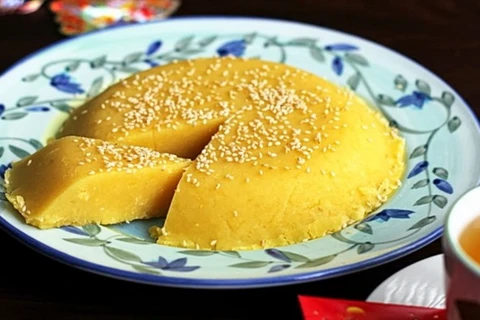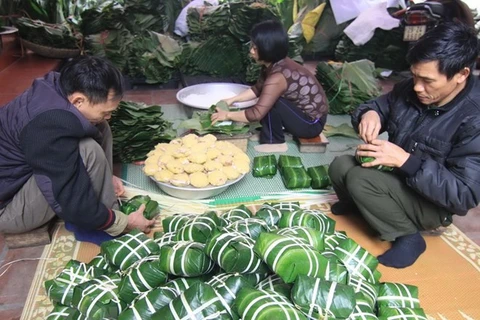Hanoi (VNA/VNS) - If rice is a staple of Vietnamese daily meals, then Gio (Vietnamese sausage) is considered the staple of special occasions, such as Tet (the Lunar New Year), wedding parties and ancestors’ death anniversary.
Traditionally, Gio is made from minced lean pork tightly encased in fresh banana leaves rolled into a cylindrical shape and boiled. A roll of Gio is then cut into slices about 2 centimetres thick and then cut into smaller parts before being served.
["Banh Chung" - The soul of Vietnamese New Year]
On the week-long Tet holiday, the most important celebration on the Vietnamese calendar, almost every family will stock at least a roll of Gio, along with Banh chung (square sticky rice cakes) and boiled chicken.
Decades ago, meat was scarce and only served on special occasions. On ancestor death anniversaries, for instance, the women of the family would prepare an elaborate set of dishes, among which Xoi (steamed sticky rice), boiled chicken and a plate of neatly-placed Gio slices were a must.
The best quality Gio can be traced to Uoc Le, a tranquil village about 30 kilometres from Hanoi’s centre.
There are no official documents about the genesis of Gio in the village, yet according to 65-year-old native Nguyen Van Mui, head of the village senior citizens association, Uoc Le people have been making Gio for at least 100 years.
Currently, more than 90 percent of village households still make Gio. “As people in our neighbourhood alone can’t consume such large amounts of Gio, villagers have to migrate to other regions to sell their products,” said Nguyen Viet Tuong, head of Uoc Le village. “Uoc Le people are now present all over the country. They return on special occasions only.”
“Doing this job requires hard work. People have to wake up as early as 3am. The high quality of our Gio is attributed to several factors. One of them is the meat,” said Le Tien Manh, a 45-year-old Gio maker. “The type used in making Gio must be lean meat, fresh and a bit sticky on its surface.”
Fish sauce and seasoning are added to the minced meat before the mixture is encased tightly in layers of banana leaves, which give the Gio a unique taste. The fresh minced meat is well blended with the tartness and slight bitterness of the fresh banana leaves when they are boiled.
“It takes about an hour to get the mixture finely cooked. One can tell if Gio is well-cooked by throwing it onto a hard surface. If it bounces, the Gio is good,” said Manh.
Other variants of Gio include Cha (a mixture of minced pork deep fried with pepper or cinnamon ) and Gio bo (beef sausage). They are all eaten generally with rice, Xoi (steamed sticky rice), Banh cuon (steamed rice pancakes) or Banh mi (Vietnamese baguette). –VNA/VNS
























